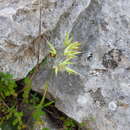Comments
provided by eFloras
The presence of this species in China has not been confirmed.
- license
- cc-by-nc-sa-3.0
- copyright
- Missouri Botanical Garden, 4344 Shaw Boulevard, St. Louis, MO, 63110 USA
Description
provided by eFloras
Annual. Culms erect or obliquely ascending, 20–60 cm tall, glabrous. Leaf sheaths pubescent; leaf blades 5–10 cm × 2–4 mm, flat, scattered pubescent. Panicle lax, 5–10 cm, erect or nodding; branches 1 or 2(–5) per node, slender, recurved, glabrous, each bearing 1–3 spikelets; pedicels about as long as or longer than spikelet. Spikelets lanceolate, 10–15(–25) mm, with curved pubescence; rachilla internodes short, not exposed; glumes unequal, lower glume 4–5 mm, upper glume 6–8 mm; lemmas oblong-lanceolate, 7–9 mm, pubescent, margins narrowly membranous, apex deeply 2-toothed, teeth 2–3 mm; awn 5–9 mm, base slightly flattened and twisted, spreading or recurved; palea shorter than lemma. Anthers ca. 1 mm. Fl. and fr. Apr–Jul. 2n = 14.
- license
- cc-by-nc-sa-3.0
- copyright
- Missouri Botanical Garden, 4344 Shaw Boulevard, St. Louis, MO, 63110 USA
Distribution
provided by eFloras
Xinjiang [N Africa, SW Asia, S Europe].
- license
- cc-by-nc-sa-3.0
- copyright
- Missouri Botanical Garden, 4344 Shaw Boulevard, St. Louis, MO, 63110 USA
Habitat
provided by eFloras
Moist places in fields, deciduous forests; 1200–1800 m.
- license
- cc-by-nc-sa-3.0
- copyright
- Missouri Botanical Garden, 4344 Shaw Boulevard, St. Louis, MO, 63110 USA
Synonym
provided by eFloras
Bromus hordeaceus Linnaeus var. intermedius (Gussone) Shear; B. lanceolatus Roth subsp. intermedius (Gussone) Lloret; Serrafalcus hughii Todaro.
- license
- cc-by-nc-sa-3.0
- copyright
- Missouri Botanical Garden, 4344 Shaw Boulevard, St. Louis, MO, 63110 USA
Bromus intermedius: Brief Summary
provided by wikipedia EN
Bromus intermedius, the intermediate brome, is a species of flowering plant in the family Poaceae. It is native to the Mediterranean countries and islands, and eastwards to Afghanistan. It can be found growing on serpentine soils.
- license
- cc-by-sa-3.0
- copyright
- Wikipedia authors and editors

